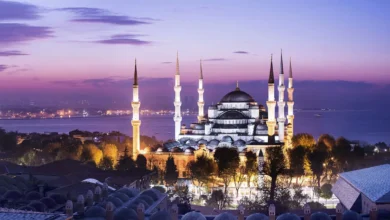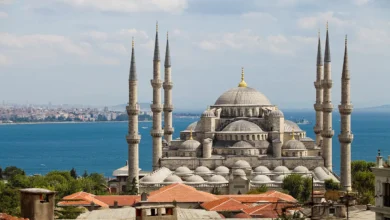
Helsinki Cathedral is a stunning symbol of Finland’s national identity, located in the heart of Helsinki. Originally designed by Carl Ludvig Engel, the cathedral was completed in 1852. It stands as the focal point of Senate Square, surrounded by significant buildings such as the Helsinki University and the Government Palace. The neoclassical style of the cathedral, with its grand columns, white facade, and soaring dome, makes it one of the most recognizable landmarks in Finland.
The cathedral was initially known as St. Nicholas Church, named after the Russian tsar Nicholas I, who started its construction. After Finland’s independence, it became known as Helsinki Cathedral. It features a distinctive Greek cross design, with six Corinthian pillars supporting its pediment, and is adorned with statues of the twelve apostles along its roofline. These statues, made of zinc, were added after Engel’s death by architect Ernst Lohrmann, who also introduced pavilions on each side of the cathedral’s grand staircase.
Today, the cathedral remains an active place of worship and is a popular tourist destination. The cathedral’s crypt hosts exhibitions and the Cathedral Shop, making it a key cultural spot in Helsinki
History and Architecture
Construction and Design
The construction of Helsinki Cathedral began in 1830, following Finland’s integration into the Russian Empire. Tsar Nicholas I commissioned the cathedral to be built as a grand symbol in the heart of Helsinki. A competition was held, and Carl Ludvig Engel’s neoclassical design was selected. The construction process stretched over two decades, with various architectural changes introduced during this time. Notably, Engel’s original design was enhanced with additional domes and decorative elements by his successor, Ernst Lohrmann, after Engel’s death. The cathedral was completed and inaugurated in 1852.

Architectural Features
Helsinki Cathedral is a prime example of neoclassical architecture, distinguished by its elegant green dome and towering white Doric columns. The cathedral’s design is influenced by classical Greek temples, with its striking white facade and grand triangular pediment. The central dome, surrounded by four smaller domes, creates a distinctive silhouette that is a prominent feature of Helsinki’s skyline.
Inside, the cathedral continues to impress with its spacious, light-filled interior. The soaring white walls and high ceilings give the space a sense of grandeur, while natural light from large windows highlights the neoclassical details. The grand altar is a focal point, flanked by statues of the apostles. The cathedral also houses a massive pipe organ, which is a key element during religious services and concerts

Location and Accessibility
Helsinki Cathedral is strategically located in Senate Square, right in the heart of Helsinki, making it a central landmark easily accessible to both locals and tourists. Visitors can reach the cathedral on foot, via public transport, or by joining guided tours that explore the city’s historical and architectural highlights. Senate Square itself is a hub for cultural and civic activities, and the cathedral serves as a key destination for anyone visiting the area.
Visitor Information
Helsinki Cathedral is a must-see for visitors to the city. Tourists can admire the cathedral’s impressive neoclassical exterior and step inside to experience its serene and elegant interior. One of the highlights for visitors is the opportunity to climb the bell tower, which offers stunning panoramic views of the city. The cathedral also hosts a variety of concerts and events throughout the year, showcasing its excellent acoustics and enhancing the overall visitor experience.
Opening Hours and Admission
The Helsinki Cathedral is open to visitors daily from 9:00 AM to 6:00 PM. Admission is free, allowing people to explore its majestic interior and grounds, though opening hours may vary for special events or church services. It’s advisable to check the official website or local tourism sources for any updates, particularly during busy seasons or holidays.

Guided Tours
For those seeking a deeper understanding of Helsinki Cathedral, guided tours are available to enhance your experience. These tours are held on weekdays, particularly during the summer, and offer insightful commentary on the cathedral’s architecture, historical significance, and cultural importance. If you’re part of a group, private tours can also be arranged by request. For more detailed information on scheduling and pricing, it’s best to visit the official Helsinki Cathedral website or contact them directly.
You can also join other walking tours around the city that feature Helsinki Cathedral as part of a broader exploration of Helsinki’s landmarks, such as the Presidential Palace and Senate Square
Nearby Attractions
Helsinki Cathedral is surrounded by several remarkable attractions that are within walking distance, offering visitors a diverse range of experiences:
- Senate Square: Right next to the cathedral, this historic square is home to some of Helsinki’s most iconic buildings, including the Government Palace and the University of Helsinki. It’s also a hub for various events, such as concerts and festivals.
- Uspenski Cathedral: A short walk from the Helsinki Cathedral, this Eastern Orthodox cathedral stands out with its stunning red brick architecture and gold domes. It is the largest Orthodox church in Western Europe.
- Esplanade Park: Just a few minutes away, this green space offers a peaceful escape with beautiful walking paths, cafes, and views of the harbor. It’s a popular spot for locals and tourists alike to relax and enjoy the Finnish summer.
- Market Square (Kauppatori): A bustling open-air market where you can buy fresh Finnish produce, souvenirs, and enjoy local foods. It’s located near the waterfront, offering scenic views of the harbor.
- Suomenlinna Sea Fortress: A UNESCO World Heritage site, this sea fortress is a short ferry ride from the city center and offers rich history, scenic views, and opportunities for outdoor activities
A Journey Through Time:
Senate Square: The grand Senate Square, where Helsinki Cathedral stands, is a historic hub that tells the story of Finland’s past. The iconic statue of Tsar Alexander II commemorates Finland’s time as a Grand Duchy under Russian rule. Surrounding the square are architectural gems like the Government Palace, University of Helsinki’s main building, and the Sederholm House, home to the Helsinki City Museum. These buildings represent a mix of neoclassical, baroque, and other architectural styles, highlighting the city’s transformation through the centuries.
National Museum of Finland: Just a short walk from the cathedral, the National Museum of Finland offers an immersive journey through the country’s history. It features a wealth of archaeological finds, artwork depicting Finnish landscapes and historical milestones, and exhibits on the indigenous Sámi people. The museum is an excellent resource for understanding Finland’s cultural evolution and heritage

A Cultural Delights:
Ateneum Art Museum: A must-visit for art lovers, the Ateneum Art Museum showcases an impressive collection of Finnish art spanning the Golden Age to contemporary works. Among the highlights are masterpieces by renowned Finnish artists such as Akseli Gallen-Kallela and Jean Sibelius, as well as international icons like Vincent van Gogh and Claude Monet. The museum offers a deep dive into both Finnish and global art history, making it an essential stop for culture enthusiasts.
Esplanadi Park: Often referred to as the “lungs of the city,” Esplanadi Park provides a peaceful retreat from the hustle and bustle of Helsinki. Lined with charming cafes and restaurants, the park is a popular spot for relaxing, people-watching, or enjoying a picnic. During the summer, the park becomes a lively hub for street performers and musical events, adding a festive touch to the city center.
Swedish Theatre: Just steps from Helsinki Cathedral, the Swedish Theatre is a historic cultural venue that offers a rich variety of performances. Founded in the late 18th century, the theater is home to a diverse repertoire, including classic plays and contemporary dramas. Even if you don’t speak Swedish, the theater’s beautiful architecture and vibrant atmosphere make it worth a visit.

Beyond the Square:
Kauppatori Market Square: Located just south of Helsinki Cathedral, Kauppatori is a lively market that offers a variety of Finnish delights. The square is filled with vendors selling fresh produce, local crafts, and delicious street food. During summer, you can sample fresh berries, while smoked salmon and hearty fish soup are available year-round. The market’s bustling atmosphere makes it a great place to experience local culture and cuisine.
Suomenlinna Fortress: A short ferry ride from Kauppatori, Suomenlinna is a UNESCO World Heritage site that offers a unique historical experience. The fortress, spread across several islands, features impressive fortifications, tunnels, and museums. Visitors can explore the fortress grounds and enjoy panoramic views of the Helsinki skyline from the ramparts. It’s a perfect destination for history lovers and those looking for scenic beauty
Events and Activities
Helsinki Cathedral offers a vibrant schedule of events and activities that enhance its cultural and spiritual significance. These include regular religious services, art exhibitions, concerts, and cultural festivals throughout the year. One notable event is the Via Crucis performance, held at Senate Square on Easter Saturday, which blends music, theater, and community tradition.
Additionally, the cathedral hosts seasonal events like the Christmas services and concerts that draw crowds looking to experience the holiday spirit in a historic setting. For more detailed and updated event listings, you can check platforms like My Helsinki for specific dates and additional activities
Cultural Significance
Helsinki Cathedral holds great cultural significance in Finland, both as a place of worship and as a symbol of Finnish national identity. Originally built under the Russian Empire’s rule in the 19th century, it was initially named St. Nicholas’ Church after Tsar Nicholas I. After Finland gained independence, it became a symbol of Finnish sovereignty. Its role in national celebrations and religious services reinforces its cultural importance. The cathedral is closely associated with Finnish history and identity, serving as a backdrop for key public events and national commemorations.





